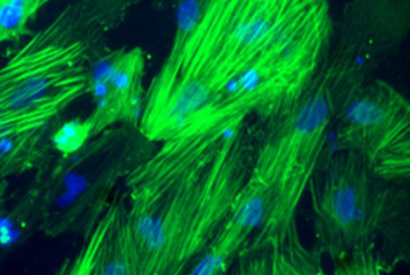Physical Features Replace Chemicals in Transforming Mature Cells to Stem Cells


Stem cells made by UC Berkeley researchers are seen here transforming into muscle tissue. Smooth muscle actin protein is highlighted in green, and cell nuclei are shown in blue. (Image courtesy of Song Li’s Lab)
Researchers at UC Berkeley are reporting on a breakthrough in substituting biochemicals with 3D physical features to revert mature human and mouse cells back to embryonic stem cell stage.
Embryonic stem cells hold the unique ability to transform into any cell in the body. For example turning into nerve cells, this can be used in regenerative medicine to repair damaged spinal cords. In 2012 another group researchers reported success in transforming mature cells into embryonic pluoripotent stemcells by using biochemical compounds, for which they received the 2012 Nobel Prize in Physiology. Their method today is the backbone of regenerative medicine, drug screening and disease modeling.
The study, reporting success in replacing these biochemical compounds with physical features of biomaterials was reported in Nature Materials published on Oct 20. Cells taken from mouse ears and human skin were cultured in parallel grooves (10 micrometer wide and 3 micrometers high) which after two weeks reverted to their embryonic pluripotent stem cell stage. When compared to cells that were grown on flat surfaces in T-Flasks, there was a noticeable fourfold increase in the number of reverted embryonic cells. By creating an environment akin to what a cell would experience inside the body, the researchers were able to put the mature cells through the same physical conditions.
The method described by the Berkeley Cell and Tissue Engineering Lab researchers lead by Timothy Downing, overcomes many of the drawbacks of biochemical based stem cell transformation. Currently the genes of mature cells are altered using gene altering proteins that are inserted using viruses, alongside an assortment of chemicals that could seriously alter the DNA of the cells that have unpredictable long-term effects. The use of physical cues to revert the cells also had a noticeable increase in the efficiency of cell transformation. Researchers are now looking at ways to transform these pluripotent cells using physical factors into neurons and other cells for use in regenerative medicine.
Source: Berkeley News
